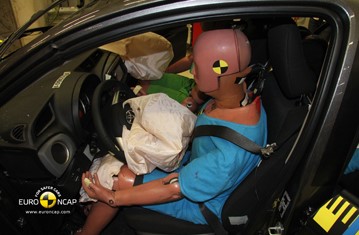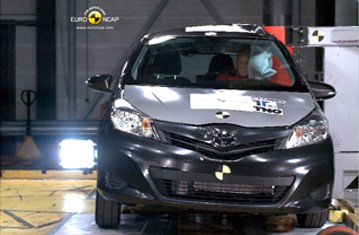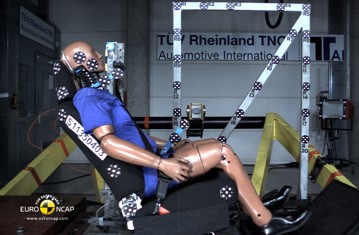Find more information in the General Comments section of the assessment
Find more information in the Rating Validity tab of the assessment
- See More
- See More
- See More
- See More
- Good
- Adequate
- Marginal
- Weak
- Poor
 Passenger
Passenger
 Driver
Driver
 Front Seat
Front Seat
 Car
Car
 Pole
Pole
- Good
- Adequate
- Marginal
- Weak
- Poor


Passenger
outboard
center
Fitted to the vehicle as standard
Not fitted to the test vehicle but available as option
Not Available
In the frontal impact, movement of the 3 year dummy, sat in a forward facing restraint, was not excessive. In the side impact, both dummies were properly contained by the shells of their restraints. The passenger airbag can be disabled by means of a switch to allow a rearward facing restraint to be used in that seating position. Clear information is provided to the driver regarding the status of the airbag and the system was rewarded. The dangers of using a rearward facing seat in the position without first disabling the airbag are explained in permanently attached labels.
- Good
- Adequate
- Marginal
- Weak
- Poor

Head Impact 15.3 Pts
Pelvis Impact 0.1 Pts
Leg Impact 6.0 Pts
The bumper scored maximum points for protection of dummies' legs. The front edge of the bonnet was predominantly poor. In those areas likely to be struck by a child's head, the bonnet offered predominantly good protection, as it did for an adult's head.
- Good
- Adequate
- Marginal
- Weak
- Poor
| Performance | ||
| Vehicle Yaw Rate @ COS + 1.00 s | 9.700001% | meets ECE requirements |
| Vehicle Yaw Rate @ COS + 1.75 s | 7% | meets ECE requirements |
| Lateral Displacement @ BOS + 1.07 s | 3.18 m | meets ECE requirements |
| Applies To | All seats | ||
| Warning | Driver Seat | Front Passenger(s) | Rear Passenger(s) |
| Visual | |||
| Audible | |||
|
|||
Electronic stability control is standard equipment on all variants in most European countries but is an option on some variants in certain countries. The system met Euro NCAP's fitment requirements for 2011 and complied with the test requirements. A seat belt reminder is standard for the driver, passenger and rear seats. A speed limitation device is available as an option but did not meet Euro NCAP's fitment requirements, so was not assessed.
- Specifications
- Safety Equipment
- Videos
- Rating Validity
Specifications
Tested Model Toyota Yaris 1.3 'Active', LHD
Body Type - 5 door hatchback
Year Of Publication 2011
Kerb Weight 1050kg
VIN From Which Rating Applies - applies to all Yaris of the specification tested
Class City and Supermini
Safety Equipment
Note: Other equipment may be available on the vehicle but was not considered in the test year.
Fitted to the vehicle as standard
Fitted to the vehicle as option
Not fitted to the test vehicle but available as option
Not Available
Not Applicable
Videos
Rating Validity




Find more information in the General Comments section of the assessment
 Share
Share












In the frontal impact, the passenger compartment remained stable. Dummy readings indicated good protection of the knees and femurs of the driver and passenger. Toyota showed that a similar level of protection would be provided to occupants of different sizes and to those sat in different positions. Maximum points were awarded for protection of the driver dummy, all body areas being well protected. In the side barrier test, dummy readings indicated good protection of all body areas. In the more severe side pole test, the curtain airbag became slightly trapped behind the trim of the windscreen pillar, and the head scores for both the side barrier and side pole tests were penalised. In the pole impact, dummy readings of rib compressions indicated marginal chest protection. The seat and head restraint provided marginal protection against whiplash injuries in the event of a rear-end collision.